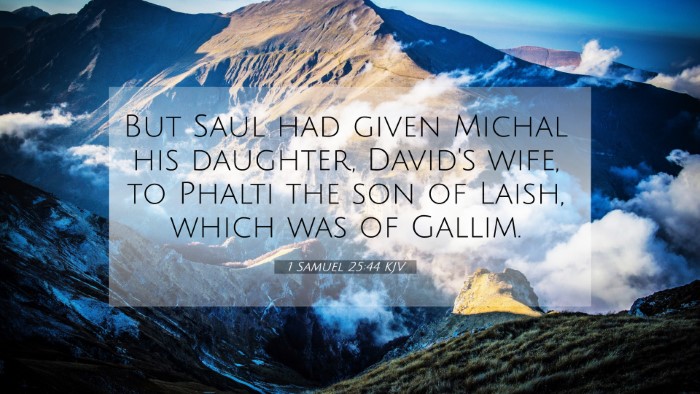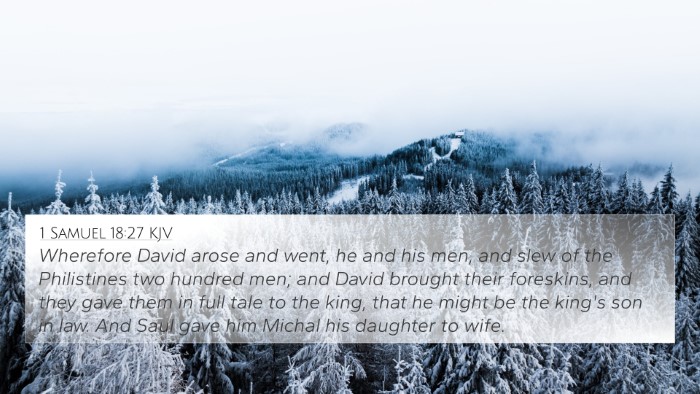Understanding 1 Samuel 25:44
In 1 Samuel 25:44, we encounter a narrative that reflects the intricate dynamics of relationships, power, and divine providence. This particular verse states,
"But Saul had given Michal his daughter, David's wife, to Palti the son of Laish, which was of Gallim."
The implications of this text reverberate through various themes in Scripture, as we explore its meaning and significance through cross-referencing other Bible verses.
Summary of 1 Samuel 25:44
This verse illustrates an act of disloyalty on King Saul's part, who, in his growing animosity toward David, takes drastic measures by giving David's wife,
Michal, to another man, Palti. This act not only highlights the personal vendetta Saul possesses against David but also raises questions about the sanctity of marriage and familial bonds.
Commentary Insights
- Matthew Henry: He emphasizes that Saul's actions are driven by jealousy and a desire to harm David indirectly through personal loss.
Michal’s transfer to another man symbolizes the ongoing conflict and turmoil within Saul's house.
- Albert Barnes: Barnes suggests that this action of Saul was a clear violation of marriage vows, introducing chaos
into the already tumultuous relationships between them. Michal being given to someone else reflects the desperation of Saul's attempts to undermine David.
- Adam Clarke: Clarke provides a deeper sociocultural context, noting that marriages during this time had implications beyond personal ties; they were a reflection of alliances and power.
The separation of Michal from David signifies a break in the divinely ordained union that also reinforces Saul's rejection of God's chosen leader.
Thematic Connections
The themes surrounding 1 Samuel 25:44 extend far beyond its immediate narrative. They touch upon the broader themes of loyalty, betrayal, and God’s
providence throughout the Bible. Exploring related verses enhances our understanding of these themes.
Cross-References
- 1 Samuel 18:27: Here we see David’s original marriage to Michal, emphasizing the foundation of their relationship.
- 2 Samuel 3:13-16: This passage discusses the retrieval of Michal by David, highlighting the significance of their union in David's claim to the throne.
- 1 Samuel 19:11-12: Michal's loyalty to David is shown as she defies her father Saul to protect her husband.
- 2 Samuel 6:20-23: Michal's reaction to David's worship further illustrates the complexities of their relationship.
- Romans 13:1: This verse reflects on the divine authority and the role of leaders, linking to Saul's kingship and his subsequent rejection.
- Matthew 19:6: A New Testament reflection on the sanctity of marriage, underscoring the betrayal of Michal's setting in this story.
- Proverbs 5:15-17: This warns about the consequences of infidelity and highlights the importance of marital fidelity relevant to Michal's situation.
Exploring Connections Between Bible Verses
The importance of cross-referencing in biblical studies cannot be overstated; it allows for a nuanced understanding of a verse's context
and its application. Through the links provided, we witness how personal relationships and divine choices intertwine throughout Scripture.
The act of Saul giving Michal to another man serves as a critical juncture in understanding the tensions that exist in the narrative arc of David's rise to the throne.
It invites readers to draw connections not only within the historical books of the Old Testament but also into the teachings of Jesus and the epistles found in the New Testament.
Using Tools for Bible Cross-Referencing
To uncover the depths of the biblical text, various resources such as a Bible concordance or a cross-reference guide can be employed.
These tools help users identify meaningful connections between verses, enhancing their study and interpretation of scripture.
Conclusion
The account in 1 Samuel 25:44 serves as a stark reminder of the personal conflicts that can emerge within the context of divine plans.
Understanding this verse through the lens of cross-referencing allows us to draw parallels and themes that resonate throughout both the Old and New Testaments.
Researchers and students of the Word are encouraged to delve deeper into these connections, uncovering the rich tapestry of God's narrative through scriptural references.






